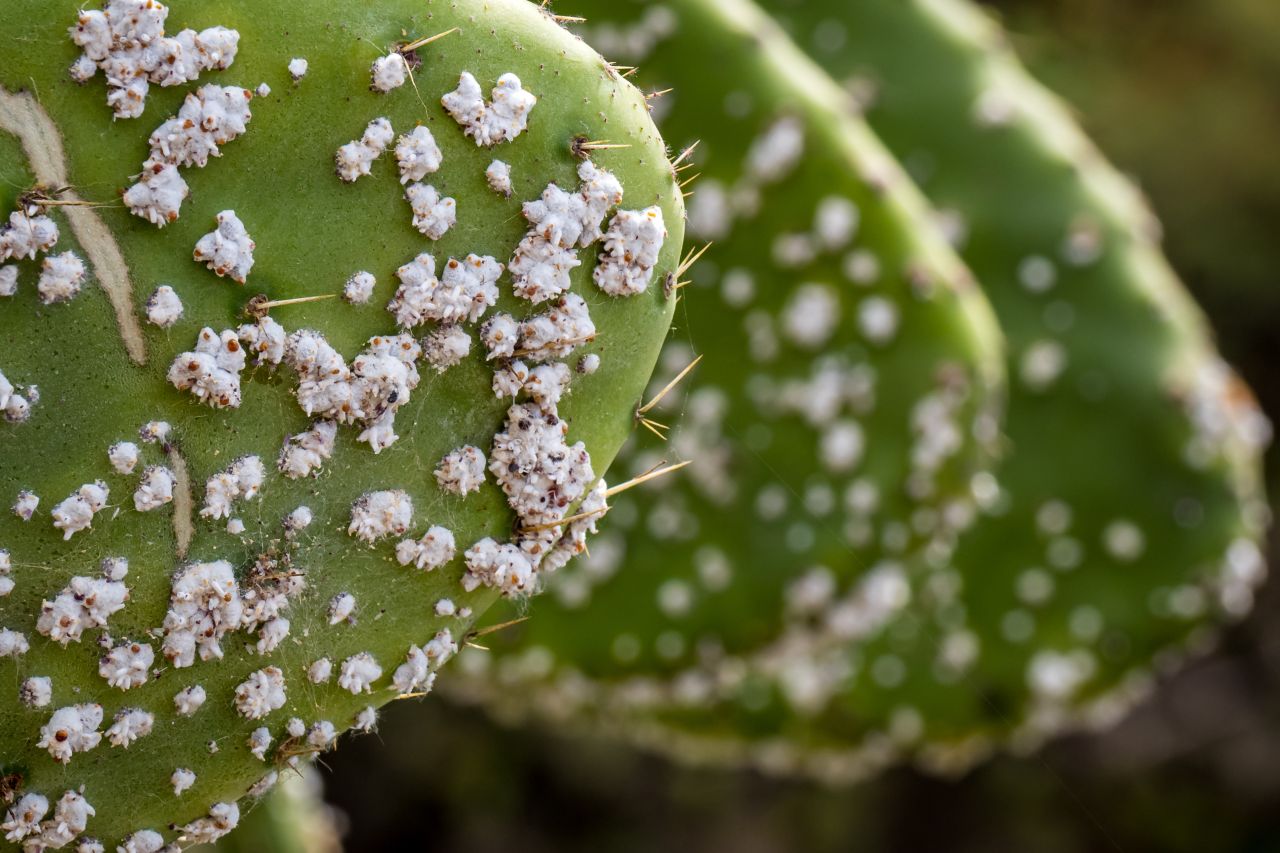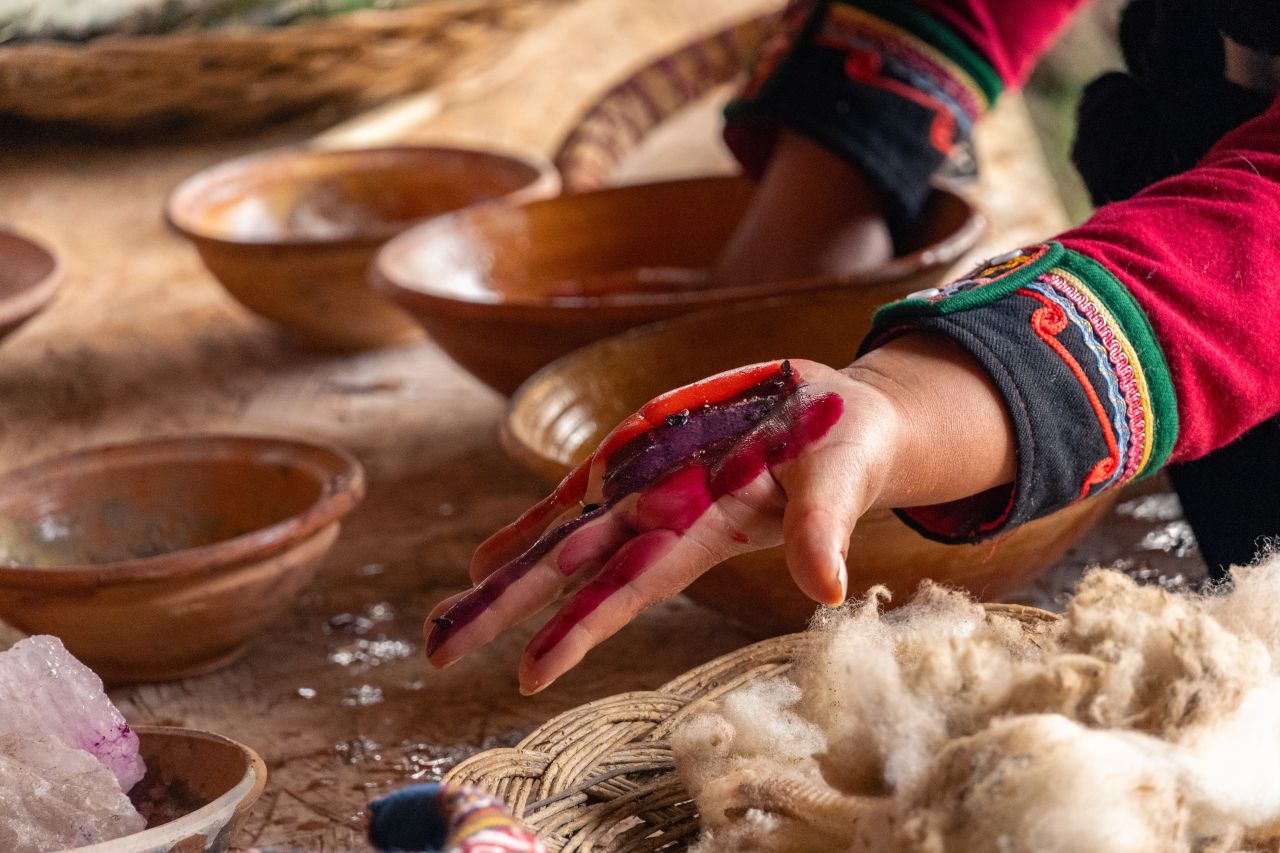Lipids from insects in cosmetics and personal care products
Insect lipids offer an innovative and sustainable alternative to conventional cosmetic ingredients. Their diverse fatty acid profile and environmental benefits make them valuable for personal care products. Only one hurdle remains: overcoming consumer hesitation.

Cochineal farming involves cultivating prickly pear cacti to host cochineal insects. Image: Adobe Stock
A historical perspective
The use of insect-derived ingredients in cosmetics dates back centuries. Ancient civilizations, such as the Egyptians, incorporated insect extracts into beauty products for pigmentation, fragrance, and preservation. Carminic acid from cochineal insects has been used as a natural red dye in lipsticks and rouges for centuries. The Chinese and Greeks also utilized insect-based substances for medicinal and cosmetic applications, recognizing their beneficial properties for skin protection and rejuvenation. During the Renaissance, crushed insects were commonly used in European cosmetics to create vibrant pigments for makeup and textiles.

Cochineal insects are harvested for their red carminic acid dye. Image: Adobe Stock
The Aztecs and Maya harvested cochineal insects extensively to produce red dyes for both textiles and body painting, demonstrating the long-standing use of insects in enhancing appearance. Even in the 19th century, insect-derived substances like shellac, secreted by the lac bug, were used in hair and nail polishes, further illustrating the historical dependence on insect-based products for aesthetic enhancement.
With the advent of industrialization, synthetic alternatives largely replaced natural insect-based ingredients due to cost and scalability. However, as sustainability concerns rise and natural ingredients regain popularity, biotechnology is bringing insect-derived compounds back into the spotlight. Today, research highlights the potential of insect lipids as an eco-friendly and functional resource in the cosmetics industry, offering a compelling alternative to traditional animal- and plant-based oils. This renewed focus aligns with the cosmetics industry's growing commitment to sustainability and ethical sourcing.
Insect-derived molecules and their benefits
Insects provide various bioactive molecules, including fatty acids, peptides, and lipids which have numerous applications in cosmetics. For example, lauric acid, myristic acid, palmitic acid, and oleic acid are among the most commonly extracted lipids from black soldier fly larvae. These molecules serve as emollients, surfactants, and antimicrobial agents. The high concentration of saturated fatty acids in insect lipids supports skin hydration, elasticity, and repair mechanisms, making them highly functional for dermatological applications.
Unlike traditional plant-based sources such as palm oil, insect lipids offer significant advantages in terms of land and water efficiency, making them a more sustainable option.
Moreover, the ability of insects to transform organic waste into valuable cosmetic ingredients enhances their ecological appeal. Additionally, animal-derived lipids are biodegradable, reducing environmental impact compared to synthetic chemicals, thus aligning with green chemistry initiatives in cosmetics.
Insect-derived bioactive molecules, including lipids, peptides, and chitosan, are extracted from larvae, pupae, or adult insects through various methods depending on the species and the target compound. Typically, insects are euthanized through freezing or dehydration to preserve their biochemical integrity. Lipids, such as those from black soldier fly larvae, are obtained through mechanical pressing or solvent extraction, while bioactive peptides are derived by enzymatic digestion of mealworm proteins. Chitosan is extracted from insect exoskeletons like those of the silkworm.
Traditional lipid extraction methods, such as solvent-based extraction, often rely on hexane or other petroleum-derived solvents, which can pose environmental and health concerns due to volatile organic compound (VOC) emissions and hazardous waste generation. Emerging technologies such as enzymatic extraction and supercritical CO₂ extraction promise higher purity lipids with minimal environmental impact. Enzymatic extraction utilizes biodegradable enzymes to break down insect biomass in a controlled manner, reducing the need for harsh chemicals while improving lipid recovery efficiency. Similarly, supercritical CO₂ extraction, a solvent-free process, uses pressurized carbon dioxide to extract lipids, ensuring high purity while eliminating toxic residues. Although these advanced methods require higher initial investment and energy input, they improve the cost efficiency of insect lipid production in the long run by reducing waste, increasing lipid yield, and enhancing sustainability. As research progresses, optimizing these techniques will be crucial for making insect-derived lipids a viable and scalable alternative to traditional plant- and animal-based oils.
Applications of insect lipids in cosmetics
Lauric acid, found in abundance in black soldier fly larvae, possesses antibacterial properties, making it ideal for cleansing products, soaps, and antimicrobial creams. Its natural antimicrobial action makes it suitable for acne-prone skin formulations. Myristic acid, present in mealworms, is widely used in moisturizers and emollients for its skin-conditioning properties, providing a silky and lightweight texture. Palmitic acid contributes to hydration and is commonly included in creams and lotions to enhance texture and moisture retention, offering improved barrier protection. Oleic acid, abundant in crickets and locusts, strengthens the skin barrier and is frequently utilized in anti-aging and hydrating formulations.
These lipid components can also be modified into esters and emulsifiers to improve the stability and absorption of skincare formulations, making them an essential ingredient in advanced dermatological research. Beyond skincare, insect-derived lipids are being explored for their potential in haircare and sun protection products. Their natural lipid profile helps condition hair while offering UV protection, making them a viable alternative to synthetic silicones and mineral oils. The use of these lipids in solid shampoo bars and biodegradable packaging solutions further exemplifies their potential in sustainable beauty innovations.
While insect-derived ingredients are increasingly used in the cosmetics industry, consumer awareness remains limited, as these components are often listed under their chemical names, making their origin unclear. For example, carminic acid, derived from cochineal, is commonly used in lipsticks and blushes but is rarely recognized by consumers as an insect-derived pigment. Similarly, shellac, obtained from the lac bug, functions as a natural resin in nail polishes and hair sprays, yet its insect origin is not always disclosed in an explicit way (Lionetti & Rigano, 2018). In Europe, cosmetic labeling is regulated under Regulation (EC) No 1223/2009, which mandates full disclosure of ingredients using their INCI (International Nomenclature of Cosmetic Ingredients) names. However, no specific labeling requirements exist to indicate the biological origin of these compounds (Marcotrigiano et al., 2018). This can lead to consumer misconceptions, as individuals who might avoid insect-derived products for ethical, religious, or allergy-related reasons may unknowingly use them. It was shown that labeling products explicitly as containing insect-derived ingredients tends to reduce consumer willingness to purchase them, even when the products have identical formulations (Modlinska et al., 2020). This suggests that manufacturers may have a commercial incentive to minimize the visibility of insect-based ingredients on product labels. Regarding allergenicity, insect-derived ingredients can contain potential allergens, particularly tropomyosin, which is structurally similar to allergens found in crustaceans. A risk assessment highlighted that individuals allergic to shellfish might also react to insect-derived proteins, although the refining process of cosmetics typically removes most allergenic compounds (Garino et al., 2020). However, no mandatory allergen warnings currently exist for insect-derived cosmetic ingredients, leaving potential risks unaddressed.
References
Lionetti N & Rigano L. 2018. Labeling of cosmetic products. Cosmetics 5;1:22. https://doi.org/10.3390/cosmetics5010022
Marcotrigiano V et al. 2018. Food labelling: Regulations and public health implications. Ann. Ig. 30;3:220-228. DOI: 10.7416/ai.2018.2213
Modlinska K et al. 2020. The effect of labelling and visual properties on the acceptance of foods containing insects. Nutrients 12;9:2498. DOI: 10.3390/nu12092498
Garino C et al. 2020. Quantitative allergenicity risk assessment of food products containing yellow mealworm (Tenebrio molitor). Food and Chemical Toxicology 142:111460. DOI: 10.1016/j.fct.2020.111460

References of the table
Franco A et al. 2022. Lipids from Insects in Cosmetics and for Personal Care Products. Insects 13;1:41. https://doi.org/10.3390/insects13010041
Saidalavi R et al. 2017. Analysis of lead and arsenic in cosmetics and assessment of students awareness about cosmetic toxicity. International Journal of Basic & Clinical Pharmacology 6;6: 1426–1430. https://doi.org/10.18203/2319-2003.ijbcp20172235
Triunfo M et al. 2021. Lipids from Insects in Cosmetics and for Personal Care Products. Cosmetics 8;2:40 https://doi.org/10.3390/cosmetics8020040
Verheyen GR et al. 2018. Insects as an Alternative Source for the Production of Fats for Cosmetics. J Cosmet Sci 69;3:187-202. https://pubmed.ncbi.nlm.nih.gov/30052193/
Ning B. et al. 2023. Insect bioactive compounds and their potential use in animal diets and medicine. Entomological research 53;11:429-443. https://doi.org/10.1111/1748-5967.12682
Kim W et al. 2023. Research on the Value of Crickets as Ingredients for Cosmetics. IJHSR 5;3:125-130.https://doi.org/10.36838/v5i3.21
Market availability of insect-derived products in cosmetics
Insect-derived ingredients are increasingly present in the European cosmetics market, though their use remains relatively niche.
- Carmine (E120) is found in many commercial lipsticks, including brands such as MAC, NARS, and L’Oréal.
- Shellac (E904) is used in Sally Hansen and Revlon nail polishes for its glossy, long-lasting finish.
- Beeswax (E901) is a natural wax secreted by honeybees. It is widely used in cosmetics, skincare, haircare, and pharmaceuticals due to its emollient, protective, and thickening properties.
- Chitosan appears in high-end skincare and hair treatments, often labeled as a hydrating or film-forming agent.
- Lauric & myristic acid from black soldier fly are gaining traction in eco-friendly soap brands and natural skincare formulations.
- Cricket extracts are being explored in UV-protection and anti-aging creams, though still a niche market.
Societal perception and challenges
Consumer acceptance of insect-derived lipids remains a challenge. While environmentally conscious consumers appreciate their sustainability, cultural biases and the "yuck factor" hinder widespread adoption. Many individuals hesitate due to misconceptions regarding hygiene or are concerned about insect welfare, despite the eco-friendly benefits. Enhancing public perception through consumer education, certification, and branding efforts will be crucial.
Brands must adopt transparent marketing strategies, emphasizing the sustainability and dermatological benefits of insect-based ingredients. Beyond societal acceptance, regulatory hurdles must be addressed, as insect-derived ingredients need to comply with various cosmetic safety regulations. The European Union and other governing bodies are gradually adapting regulations to accommodate novel sources like insect lipids, but further standardization is required. Additionally, cosmetic manufacturers must work to overcome initial reluctance and integrate insect-derived ingredients into mainstream products through targeted collaborations and product innovations.
References
Nejad HE & Nejad AE. 2013. Cochineal (Dactylopius coccus) as one of the most important insects in industrial dyeing. International journal of Advanced Biological and Biomedical Research 1;11:1302-1308. https://www.ijabbr.com/article_7910.html
Akçay AA. 2024. The Use of Insect Pigment in Art Works. Insects 15;7:519. https://doi.org/10.3390/insects15070519
Kritsky G. 2024. A cultural history of insects in antiquity. Bloomsbury Publishing. ISBN: 9781350003217
Franco A et al. 2021. Lipids from insects in cosmetics and for personal care products. Insects 13;1:41. https://doi.org/10.3390/insects13010041
Ngo HM & Moritaka M. 2021. Consumer attitudes and acceptance of insects as food and feed: a review. Journal of the Faculty of Agriculture Kyushu University 66;2:259-266. https://doi.org/10.15017/4486558
Halloran A et al. 2017. Life cycle assessment of cricket farming in north-eastern Thailand. Journal of cleaner production 156:83-94. https://doi.org/10.1016/j.jclepro.2017.04.017
Verheyen GR et al. 2018. Insects as an alternative source for the production of fats for cosmetics. J Cosmet Sci 69;3:187-202. https://pubmed.ncbi.nlm.nih.gov/30052193/
Verheyen GR et al. 2023. The application of mealworm (Tenebrio molitor) oil in cosmetic formulations. European Journal of Lipid Science and Technology 125;3:2200193. https://doi.org/10.1002/ejlt.202200193
Ebenebe C et al. 2021. Arthropods in Cosmetics, Pharmaceuticals and Medicine: A Review. IntechOpen. https://www.intechopen.com/chapters/75778
Salvia R & Falabella P 2021. Bioconverter insects: A good example of circular economy, the study case of Hermetia illucens. In An Introduction to the Circular Economy (pp. 261-280). Nova Science Publishers, Inc. ISBN: 978-1-53619-233-9
Almeida C et al. 2020. Bioactive compounds from Hermetia illucens larvae as natural ingredients for cosmetic application. Biomolecules 10;7:976. https://doi.org/10.3390/biom10070976
